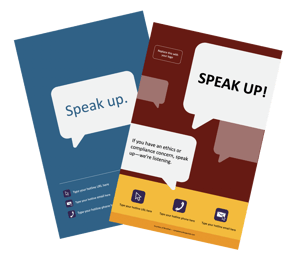
A simple reason why no one remembers your compliance training.
If you’ve been following us, you know that we think employees should not have to memorize compliance training.
That is, we advocate for avoiding the problem of memorization through good design: framing compliance training around business tasks and inserting it into process so people don’t have to memorize things.
And one of the reasons we do this is because getting people to learn and memorize compliance stuff is really hard.
Most of the "innovations" in the field—video, interactive e-learning, microlearning—seem to be efforts to promote engagement and memorization, attacking a problem that is both difficult and largely avoidable.
It's like those videos where you see a dog trying to carry a stick somewhere, but he keeps getting stuck because the stick is too long. And then the dog just keeps trying harder without ever realizing he just needs to turn sideways.
Actually, here's a nice video of exactly that from YouTube:
Haha, good doggo. Also, that dog is what I will now think of when I hear people promoting some new "innovation" to help drive engagement and retention.
And the very satisfying end of the video—where the dog figures out how to beat the problem—is how I feel when someone has the "aha!" moment that just trying harder is not the answer; they need to think about the problem differently.
But to get to that "aha!" moment, you first need to understand why the memorization thing isn't happening (and just know that I'm somewhat conflating "memorization" and "learning" here).
There are a ton of explanations for this, from a variety of fields—we'll get to you later, behavioral ethics and cognitive psychology—but I want to leverage something you've probably heard thrown around a bunch already: adult learning theory.
Ready? Here's the reason.
It doesn’t solve a problem for them.
This gets to the basics of adult learning theory, which is the thing everyone in training talks about and no one actually uses.
Here’s what I mean: one of the fundamental assumptions of adult learning theory is problem orientation—essentially, grown-ups learn to solve real-world problems, not on the assumption that abstract knowledge will eventually become helpful.
And this sits at odds with the fact that most compliance training is framed around abstract concepts and delivered in a way that has nothing do with the problems employees face, and both of those features are problems.
For example, could you do annual training in a way where the content was framed around business tasks (real-world problems) instead of abstract concepts? Sure, and that'd be a big step forward. You should start with that.
But the practice of scheduled compliance training is still a problem.
Look, if you are forcing people to take compliance training on a schedule, accept they are going to check out. Everything about that top-down, arbitrarily-timed format signals “you are a child, back in school,” and causes people to disengage.
Delivering that training in video or with interactivity doesn't change that; it just alters the signal to be "you are a child, back in school, and your teacher has a headache so we're going to watch Labyrinth in social studies today."
To that point, here’s an epic quote from page 44 of The Adult Learner, a textbook in the field that gives itself the unironic subtitle "the definitive classic in adult learning":
Adults have a self-concept of being responsible for their own decisions, for their own lives. Once they have arrived at that self-concept, they develop a deep psychological need to be seen by others and treated by others as capable of self-direction. They resent and resist situations in which they feel others are imposing their wills on them. This presents a serious problem in adult education: The minute adults walk into an activity labeled "education," "training," or anything synonymous, they hark back to their conditioning in their previous school experience, put on their dunce hats of dependency, fold their arms, sit back, and say "teach me."
Haha, burn! (Emphasis added for extra burn.)
Also, if you're interested in training, read that book. These concepts get absolutely massacred online, to the point where articles can't even get right how many core assumptions are in the field, so do yourself a favor and read the actual book.
So what should we do?
Turn the stick sideways, duh.
That is, embrace the fact that compliance training is not about trying to make people into lawyers or compliance professionals; it’s about trying to get them to do their jobs the right way.
You are not trying to get them to learn and memorize something substantively new—you are trying to get them to simply do what they are already doing in a specific way.
So, frame training around what they actually do and build it into your process so it’s available exactly when they need it. There are no bonus points if they memorize it, so don't beat yourself up trying to do that.
And if you need help, you should check out Compliance Design Club—we have a ton of compliance communications and training resources that have been designed around precisely that approach.
See how easy our materials are to customize with these free hotline posters!


